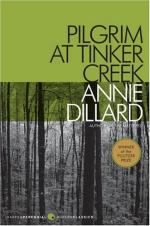
|
| Name: _________________________ | Period: ___________________ |
This test consists of 5 multiple choice questions, 5 short answer questions, and 10 short essay questions.
Multiple Choice Questions
1. How do humans insulate themselves from the present, according to the author?
(a) by wearing clothes appropriate to the weather
(b) by continuously reviewing images of the past and future in their minds
(c) by blocking out the past
(d) by lying to themselves and others
2. Dillard says the agnostic asks who created the universe. What does a believer ask?
(a) why am I in the universe
(b) why was the universe created
(c) what role does man play
(d) who is God
3. Where does Dillard makes a pilgrimage to every month?
(a) to visit her mother in another state
(b) the small town a few miles away
(c) the the local church
(d) the island that bisects Tinker Creek
4. Chlorophyll has a single atom of what substance in the center?
(a) hydrogen
(b) carbon
(c) magnesium
(d) zinc
5. What does Dillard believe is healing?
(a) flowing water
(b) soothing music
(c) white clouds in blue skies
(d) sunshine
Short Answer Questions
1. Why did Xerxes stop the advance of his entire army?
2. Why did Indians used grooved arrows?
3. How do honey bees survive the cold of winter?
4. What does Dillard see as a passive mystery?
5. Dillard thought once that awesome artistry can be laced with savagery. To what did she refer?
Short Essay Questions
1. Dillard recalls what a woman recently told her, "'Seem like we're just set down here...and don't nobody know why."' What do you think this saying means?
2. This Chapter is called "Fixed." What are some of Dillard's observations and thoughts that illustrate this title?
3. This book alternately uplifts and depresses the sensitive reader. What did you find uplifting about the first chapter? Depressing?
4. What is kayak sickness?
5. In the second section of Chapter 11, Dillard stays almost exclusively focused on one topic, seldom straying. Why do you think she is staying so focused?
6. How does Dillard feel about "shadows?" What does she write to show those feelings?
7. The "Present", Chapter 6 is also about time, but a very specific part of it, the "now." What are some of Dillard's thoughts on being in the present?
8. Briefly tell the story written in Chapter 15 about a young man and his mother.
9. Dillard believes that the death of the self is painless. What might she mean by this?
10. What does Dillard say about the trauma of people blind since birth who get their sight?
|
This section contains 1,340 words (approx. 5 pages at 300 words per page) |

|




